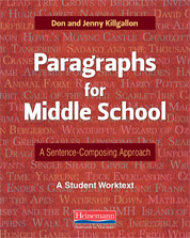Paragraphs for Middle School: A Sentence-Composing Approach
Paragraphs for Middle School: A Sentence-Composing Approach
By Don Killgallon and Jenny Killgallon
(Heinemann, 2013 – Learn more)
Every middle school Language Arts teacher will tell you that teaching all students to write concisely and coherently is a daunting task. As a teacher of sixth graders, many of whom would rather watch paint dry than learn how to write well, I am always looking for helpful, powerful resources to assist me in this process. This book, Paragraphs for Middle School, fits that bill. It is definitely one that I will add to my frequently used resources and will refer to often.

This book elaborates on that concept and offers a how-to for accomplishing that goal. It walks students through the process of composing strong paragraphs by first crafting strong sentences. The authors begin the book by stating:
Much of good writing is a process of addition. Good writers say more. Often, students don’t write better because they don’t have the tools for elaboration.
This book gives teachers the tools they can use to show their students how to write more, and by doing so, write better. The model sentences and paragraphs (mentor texts) that the authors include are from a wide variety of well-known and well-respected books and authors. The examples are authentic and come from sources that middle school students will immediately recognize and identify with.
The paragraph-building process
The Killgallons do this through a process of imitation, elaboration and creation. They quote Stephen King as saying “Imitation precedes creation.” And so students are shown numerous examples of well-crafted sentences that demonstrate a specific skill, such as writing a powerful opening or a strong closing, or deftly handling a subject-verb split. Students are given example after example to see this skill in action as demonstrated by a well-respected author, and then their attention is drawn to the way the writers handle that skill. Students then practice imitating that skill by writing their own sentences in the style modeled for them.
The authors liken this process to coloring the pictures in a coloring book. The shape and outline are provided to give a necessary structure, and the colors added by the artist make the work their own. When students are taught to imitate great writing, they use the structure provided for them and then learn to use their own words to add color and shading. By practicing this skill, students internalize the rules and tools they see repeated and are able to begin crafting their own sentences.
This process is revisited repeatedly throughout this book. The authors begin with more basic concepts and structures of sentence creation and, as the book progresses, teach students to add more layers and nuances in the creation of their own sentences. After learning each skill, students are given the opportunity to practice applying what they have learned. Once students have learned the skills involved with writing strong sentences, the authors move them to putting those sentences together to begin writing strong paragraphs.
Clear, straightforward and snobbery-free
This book is written in a clear, straightforward manner. It is easy to read and accessible and is not written solely for grammar snobs, which I appreciated immensely! It uses familiar examples to help students understand the concepts; middle school students will understand, for example, when the authors remind them that just as their bed is not nailed down to their bedroom floor, the parts of sentences are not nailed in place either. The parts of sentences are movable, fluid pieces that can be adjusted and shifted as needed to create strong sentences that will impact readers.
However, as wonderful as this book is, I frequently found myself wishing that it included reproducible copies of the examples given. The book is not written in a format that can be easily replicated to use for modeling with students. It is overflowing with relevant, powerful examples that students can learn from, but I found the format limiting. It is written as a reference handbook, and although the 65-pp. online Teacher’s Guide is useful and brimming with ideas, teachers must do the work of translating the content into a format that will be ready to use with students.
Toward the end of the book, the authors share a wonderful quote from Gaston Bachelard: “The words of the world want to make sentences and paragraphs.” I believe that this book will assist every teacher in helping students to do just that.
After reading it from cover to cover, I can already tell that this book will be one that I frequently return to as I teach my students how to strengthen their writing skills. This book offers a practical, effective strategy for helping middle school students become stronger writers who can learn to develop their own authentic voices as writers.
Also see our review of the Killgallons’ Grammar for Middle School.
Jenni Miller is a 6th grade Language Arts teacher at Montevideo Middle School in Penn Laird, Virginia. She is in her 20th year of teaching there and absolutely loves reading and writing with her middle school students every day.




































